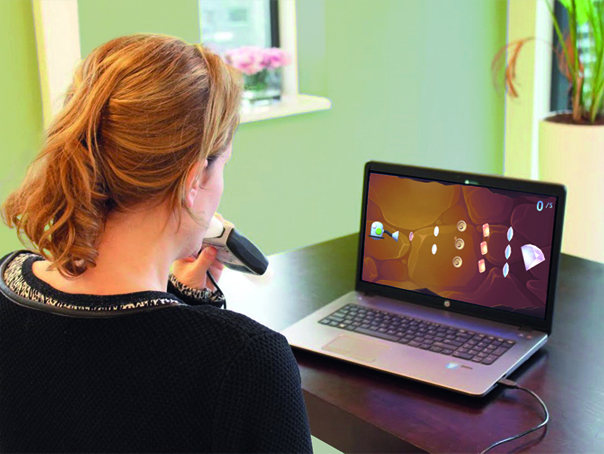Evidence based

Better gas exchange
Viera et al. (2014) have shown that breathing exercises (including sighing and maximum inhalation) increase the tidal volume and decrease the respiratory rate compared to these resting values. This results in a better gas exchange. This is important, among other things, for patients with COPD and patients who have a reduced tidal volume and increased respiratory rate after artificial respiration.
Positive effect on dyspnoea & quality of life
Dyspnea (shortness of breath) is common in people with COPD, regardless of the severity of the disease. Many of the interventions for people with COPD are aimed at reducing this symptom. Breathing exercises are physical therapy interventions. Long Alliance Netherlands describes that they have a proven beneficial effect on dyspnoea and on the quality of life. During the breathing exercises, the patient is encouraged and motivated to use the learned techniques in daily life as well. Adopting these techniques in daily life reduces anxiety and motivates people with COPD to exercise more (Long Alliance Netherlands, 2016).
Exercises recommended with COPD
The KNGF recommends inspiratory muscle strength training for COPD patients with pronounced inspiratory muscle weakness, fatigue and complaints of shortness of breath in daily life. Clinical experiences support the KNGF recommendation. Breathing exercises, including active expiration and slow and deep breathing, are recommended to reduce hyperinflation and improve gas exchange (KNGF, 2017).
Borge et al. (2014) have looked at various systematic reviews on the effect of respiratory muscle strength training on various symptoms in people with COPD. We looked at five systematic reviews, two of which were of high quality. Based on this, it was concluded that respiratory muscle strength training has a positive effect on shortness of breath, fatigue and quality of life in people with COPD. The results can be seen in the table below.
Exercising after artificial respiration is also important
Bissett et al. (2016) looked at the effect of inspiratory muscle strength training on patients after having been on ventilation for a longer period of time. Patients performed inspiratory muscle strength training. Inspirational muscle strength and quality of life increased significantly more in this group of patients (IKT group) than in patients from a control group.
Literature
Bissett, BM, Leditschke, IA, Neeman, T., Boots, R., & Paratz, J. (2016). Inspiratory muscle training to enhance recovery from mechanical ventilation: a randomized trial. Thorax, 71, 812-819.
Borge, CR, Hagen, KB, Mengshoel, AM, Omenaas, E., Moum, T., & Wahl, AK (2014). Effects of controlled breathing exercises and respiratory muscle training in people with chronic obstructive pulmonary disease: results from evaluating the quality of evidence in systematic reviews. BMC Pulmonary Medicine, 14 , 184.
Geddes, EL, O'Brien, K., Reid, WD, Brooks, D., & Crowe, J. (2008). Inspiratory muscle training in adults with chronic obstructive pulmonary disease: an update of a systematic review. Respiratory Medicine, 102, 1715-1729.
Gosselink, R., Clerckx, B., Robbeets, C., Vanhullebusch, T., Vanpee, G., & Segers, J. (2011a). Physiotherapy in the intensive care unit. Netherlands Journal of Critical Care , 15 (2), 66-75.
Gosselink, R., De, VJ, Van den Heuvel, SP, Segers, J., Decramer, M., & Kwakkel, G. (2011b). Impact of inspiratory muscle training in patients with COPD: what is the evidence? European Respiratory Journal, 37, 416-425.
KNGF (2017). KNGF guideline, Chronic obstructive pulmonary diseases.
Long Alliance Netherlands (2016). COPD care standard.
O'Brien, K., Geddes, EL, Reid, WD, Brooks, D., & Crowe, J. (2008). Inspiratory muscle training compared to other rehabilitation interventions in chronic obstructive pulmonary disease: a systematic review update. Journal of Cardiopulmonary Rehabilitation and Prevention, 28 , 128-141.
Shoemaker, MJ, Donker, S., & Lapoe, A. (2009). Inspiratory muscle training in patients with chronic obstructive pulmonary disease: the state of the evidence. Cardiopulmonary Physical Therapy Journal, 20, 5-15.
Snoeck - Stroband, JB, Schermer, TRJ, Van Schayck, CP, Muris, JW, Van der Molen, T., In 't Veen, JCCM,. . . Tuut MK (2015). NHG Standard COPD (Third Review). General Practitioner and Science, 58 (4), 198-211.
Thomas, MJ, Simpson, J., Riley, R., & Grant, E. (2010). The impact of home-based physiotherapy interventions on breathlessness during activities or daily living in severe COPD: a systematic review. Physiotherapy, 96 , 108-119.
Vieira, DSR, Mendes, LPS, Elmiro, NS, Velloso, M., Britto, RR, & Parreira, VF (2014). Breathing exercises: influence on breathing patterns and thoracic abdominal motion in healthy subjects. Brazilian Journal of Physical Therapy, 18 (6), 544-552.
 Nederlands
Nederlands  English
English  Français
Français  Deutsch
Deutsch 



